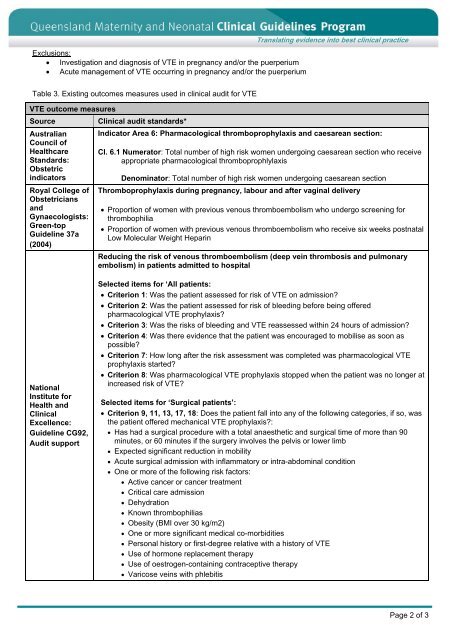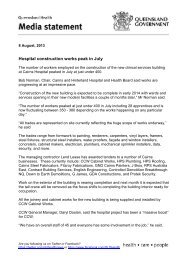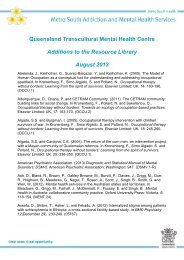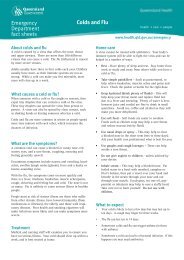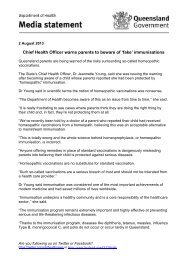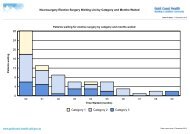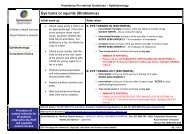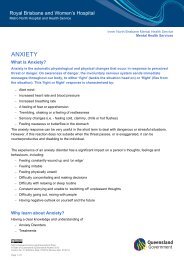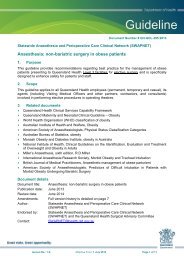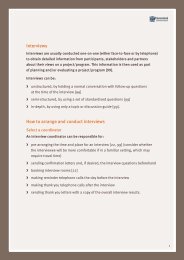Endorsed scope - Queensland Health
Endorsed scope - Queensland Health
Endorsed scope - Queensland Health
You also want an ePaper? Increase the reach of your titles
YUMPU automatically turns print PDFs into web optimized ePapers that Google loves.
Translating evidence into best clinical practice<br />
Exclusions:<br />
Investigation and diagnosis of VTE in pregnancy and/or the puerperium<br />
Acute management of VTE occurring in pregnancy and/or the puerperium<br />
Table 3. Existing outcomes measures used in clinical audit for VTE<br />
VTE outcome measures<br />
Source<br />
Clinical audit standards*<br />
Australian<br />
Council of<br />
<strong>Health</strong>care<br />
Standards:<br />
Obstetric<br />
indicators<br />
Royal College of<br />
Obstetricians<br />
and<br />
Gynaecologists:<br />
Green-top<br />
Guideline 37a<br />
(2004)<br />
Indicator Area 6: Pharmacological thromboprophylaxis and caesarean section:<br />
CI. 6.1 Numerator: Total number of high risk women undergoing caesarean section who receive<br />
appropriate pharmacological thromboprophlylaxis<br />
Denominator: Total number of high risk women undergoing caesarean section<br />
Thromboprophylaxis during pregnancy, labour and after vaginal delivery<br />
Proportion of women with previous venous thromboembolism who undergo screening for<br />
thrombophilia<br />
Proportion of women with previous venous thromboembolism who receive six weeks postnatal<br />
Low Molecular Weight Heparin<br />
Reducing the risk of venous thromboembolism (deep vein thrombosis and pulmonary<br />
embolism) in patients admitted to hospital<br />
National<br />
Institute for<br />
<strong>Health</strong> and<br />
Clinical<br />
Excellence:<br />
Guideline CG92,<br />
Audit support<br />
Selected items for ‘All patients:<br />
Criterion 1: Was the patient assessed for risk of VTE on admission?<br />
Criterion 2: Was the patient assessed for risk of bleeding before being offered<br />
pharmacological VTE prophylaxis?<br />
Criterion 3: Was the risks of bleeding and VTE reassessed within 24 hours of admission?<br />
Criterion 4: Was there evidence that the patient was encouraged to mobilise as soon as<br />
possible?<br />
Criterion 7: How long after the risk assessment was completed was pharmacological VTE<br />
prophylaxis started?<br />
Criterion 8: Was pharmacological VTE prophylaxis stopped when the patient was no longer at<br />
increased risk of VTE?<br />
Selected items for ‘Surgical patients’:<br />
Criterion 9, 11, 13, 17, 18: Does the patient fall into any of the following categories, if so, was<br />
the patient offered mechanical VTE prophylaxis?:<br />
Has had a surgical procedure with a total anaesthetic and surgical time of more than 90<br />
minutes, or 60 minutes if the surgery involves the pelvis or lower limb<br />
Expected significant reduction in mobility<br />
Acute surgical admission with inflammatory or intra-abdominal condition<br />
One or more of the following risk factors:<br />
Active cancer or cancer treatment<br />
Critical care admission<br />
Dehydration<br />
Known thrombophilias<br />
Obesity (BMI over 30 kg/m2)<br />
One or more significant medical co-morbidities<br />
Personal history or first-degree relative with a history of VTE<br />
Use of hormone replacement therapy<br />
Use of oestrogen-containing contraceptive therapy<br />
Varicose veins with phlebitis<br />
Page 2 of 3


